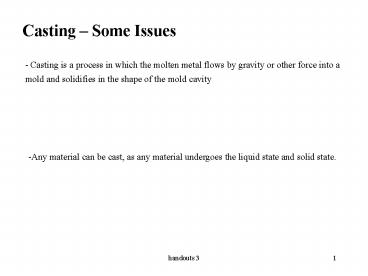Casting Some Issues PowerPoint PPT Presentation
1 / 32
Title: Casting Some Issues
1
Casting Some Issues
- Casting is a process in which the molten metal
flows by gravity or other force into a mold and
solidifies in the shape of the mold cavity
- Any material can be cast, as any material
undergoes the liquid state and solid state.
2
Casting
1. Basic Terms
3
Casting Some Issues
2. Basic Problems in Casting Processes
- Fluids must fill in the complete cavity
- Avoid shrinkage
- Mechanical property and net shape
4
Casting Some Issues
3. Thermal Analysis
- Heat metal above the melting point
- Pour it into the mold cavity
Heat energy required for (1) heat for raising the
temperature to the melting point, (2) heat of
fusion to convert the solid to the liquid, and
(3) heat for raising the molten metal to the
metal at the desired temperature ready to pour it
into a cavity.
5
Casting Some Issues
3.1 Heating Period Thermal Analysis
- heat for raising the temperature
- to the melting point
6
3.2. Thermal behavior of fluids in the cavity
In the cavity, the fluid flows and solidifies. At
this period, no further energy is fed to the
fluid.
Time needed to fill the cavity fully ?
7
TST total solidification time, min V volume
of the casting, in.3 (cm3) A surface area of
the casting, in.2 (cm2) N exponent, 2 Cm mold
constant, min.in.2 (min/cm2)
8
Cm is a function of - mold material -
thermal properties of the cast metal - pouring
temperature relative to the melting point of
the metal.
Determination of Cm can be done through
experiment.
The principle of such an experiment is to have a
scenario that is the same as the casting and a
known cavity geometry, to operate the process,
and to record the Time TST.
9
Implication of Chvorinovs Rule
A casting with a higher volume-to-surface area
ratio will cool and solidify more slowly than one
with a lower ratio.
Question How to design a casting, i.e., V, A,
materials, so that there will be a guarantee that
the molten metal will not completely solidify
before the cavity is completely filled ?
10
The solution is to have a so-called riser
Riser Reservoir
11
Casting Some Issues
- The main purpose of the riser is to overcome the
shrinkage. The reason - liquid contraction during cooling prior to
solidification
(b) contraction during the phase change from L
to S ( c) thermal contraction of the solidified
casting during cooling to room temperature
12
Casting Some Issues
3.2 Pouring stage thermal analysis
Flow rate at the base of a sprue
13
Casting Some Issues
4. Engineering analysis of pouring
Flow rate at the base of a sprue
(1)
(2)
14
Casting Some Issues
4. Engineering analysis of pouring
Mass continuity
Mass in mass out
Qv1 A1 V2 A2
(3)
compressibility of fluid is not considered
The sprue must be designed as tapered
15
Casting Some Issues
4. Engineering analysis of pouring
Time to fill the cavity
(4)
MFT considered a minimum time.
16
5. Some Design Issues
Desired functions and products
(1) Problem formulation
Casting system (casting, mold/pattern,
riser) Casting process (pouring rate, pouring
temp.)
Raw materials
Design and Control
17
Casting Some Design Issues
(2) Problem formulation
Design of Casting products (geometry) to simplify
the process and to avoid possible creation of
defects
(3) Design for locating parting lines
Parting line or parting surface is the interface
that separates the cope and drag halves of a
mold, flask, or pattern and also the halves of a
core in some core-making processes.
18
Casting Some Design Issues
- In this example, we simply change the parting
line, which consequently affects - Cores
- Draft
Example 1
19
Casting Some Design Issues
Example 2
- save cores, (b) eliminate draft,
- (c) reduce the weight
20
Casting Some Design Issues
Parting line or surface determination
- Save cores, (b) eliminate draft,
- (c) reduce the weight
Gating system
21
Casting Some Design Issues
Parting line or surface determination
Three Options
Design features, such as round, may also put
restriction to the location of parting line
22
Casting Some Design Issues
(4) Design for Controlling the process
Example 1
23
Casting Some Design Issues
Two sections intersects two problems
Stress concentration
shrinkage
Fillets
Hot spots
24
Casting Some Design Issues
Hot spot
Holes
25
Casting Some Design Issues
Additional Riser To control the shrinkage cavity
to the riser
26
Casting Some Design Issues
27
More about shrinkage
28
Solution to Cavity caused due to Shrinkage
Pattern shrinkage allowance
Large casting, special rule 1 - 5
29
Directional Solidification Forced Solidification
Design of casting system and product
(V/A)2 gt (V/A)1
30
6. Casting Process Overview
Constituents of Casting Process
How Mold is made
31
Permanent casting
Casting
Expandable casting
32
What We are Going to Look at Given a Casting
Process
Quality Requirement Function
Requirement Volume of Production

